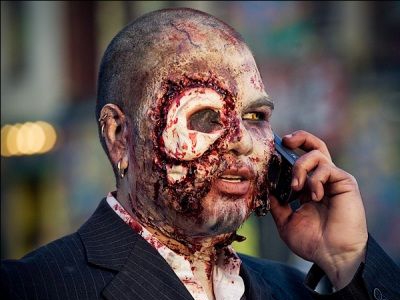FCC Considering Phone Calls on Planes Above 10,000 Feet
On October 31, the U.S. Department of Transportation’s Federal Aviation Administration (FAA) eased up on the restrictions previously set in place regarding the use of personal electronic devices. All electronic gadgets, whether they're handheld consoles, tablets or e-readers, can remain on, must be held or put in the seat back pocket, and must have the wireless portion disabled during the actual takeoff and landing.
Cell phones fall into the same group, but should be in airplane mode or with cellular service disabled during the entire flight. They also cannot be used for voice communications based on regulations imposed by the Federal Communications Commission (FCC).
"We believe today's decision honors both our commitment to safety and consumer's increasing desire to use their electronic devices during all phases of their flights," said Transportation Secretary Anthony Foxx. "These guidelines reflect input from passengers, pilots, manufacturers, and flight attendants, and I look forward to seeing airlines implement these much anticipated guidelines in the near future."
Now the Wall Street Journal is reporting that the FCC is reconsidering its ban on calls during flight. Citing unnamed sources, the paper claims that while passengers will still be restricted from making calls during landing and liftoff, the agency may allow them to make calls once the airplane reaches 10,000 feet.
According to the paper, the FCC's proposal will be sent out in what's called a "Notice of Proposed Rule Making." The agency will invite comments on the idea before making a final decision, and the process could take several months. The FCC made a similar proposal back in 2004, and received more than 8,000 comments. The proposal was dropped in 2007 due to a lack of technical information and comments made by those in the industry who said calls would be a "nuisance."
If the FCC's proposal is adopted, the FAA and airlines will have the option of allowing or banning wireless services in-flight. Will phone calls during flights be a nuisance? Honestly, do you want to sit next to a jabber mouth on a seven hour flight? No, you don't. If anything, phone calls may need to be limited in duration, but how will flight attendants police call times?
Last month the FAA released a list of things passengers should know about the expanded use of Personal Electronic Devices (PEDs) on airplanes, as shown below:
Get Tom's Hardware's best news and in-depth reviews, straight to your inbox.
1. Make safety your first priority.
2. Changes to PED policies will not happen immediately and will vary by airline. Check with your airline to see if and when you can use your PED.
3. Current PED policies remain in effect until an airline completes a safety assessment, gets FAA approval, and changes its PED policy.
4. Cell phones may not be used for voice communications.
5. Devices must be used in airplane mode or with the cellular connection disabled. You may use the WiFi connection on your device if the plane has an installed WiFi system and the airline allows its use. You can also continue to use short-range Bluetooth accessories, like wireless keyboards.
6. Properly stow heavier devices under seats or in the overhead bins during takeoff and landing. These items could impede evacuation of an aircraft or may injure you or someone else in the event of turbulence or an accident.
7. During the safety briefing, put down electronic devices, books and newspapers and listen to the crewmember’s instructions.
8. It only takes a few minutes to secure items according to the crew's instructions during takeoff and landing.
9. In some instances of low visibility -- about one percent of flights -- some landing systems may not be proved PED tolerant, so you may be asked to turn off your device.
10. Always follow crew instructions and immediately turn off your device if asked.

Kevin Parrish has over a decade of experience as a writer, editor, and product tester. His work focused on computer hardware, networking equipment, smartphones, tablets, gaming consoles, and other internet-connected devices. His work has appeared in Tom's Hardware, Tom's Guide, Maximum PC, Digital Trends, Android Authority, How-To Geek, Lifewire, and others.
-
cpatel1987 Great, its going to be adults with no volume control screaming their conversation on the plane for everyone to hear.Reply -
InvalidError With the amount of aluminum and carbon fiber between the passenger compartment and instrumentation wiring, I would be really curious to see how much of a 1W transmitter's power can actually manage to get coupled into unshielded wiring outside the passenger cabin.Reply -
Jim90 Being shoe-horned into the most uncomfortable tiny seat for hours on end is bad enough without listening to a never ending torrent of crap.Reply -
COLGeek I travel often. Honestly, I see no good coming from this policy. Just imagine how many yahoos will call all their friends just to say, "Guess where I am?" and how many business types will talk way too loud, way too long.Reply
Lots of complaints shall follow. -
invlem Use of cell phones on airplanes for everything but making phone calls - yesReply
Making calls - noooooooo!
Let people browse the internet, write emails, etc. Actual phone calls will just irritate the crap out of everyone 5 rows in each direction of the caller. -
house70 They should come up with a phone booth area on the plane, acoustically insulated from the rest.Reply
I know, almost impossible given the premium per square inch on an airplane (and the trend of turning planes into little more than flying people-herding buses), but until there is something similar to that, this phone conversation idea on a plane is just plain ridiculous. Why allow something like that, when it's common policy (and common sense) to put your phone on mute in any public enclosed space (theaters, concert halls, restaurants, etc)?
